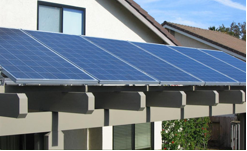Nothing says self-reliance and (energy) independence quite like a do-it-yourself (DIY) solar system. And, as a US start-up, Plugged Solar, would like to convince you, nothing says easy DIY better than a solar system you can plug in to your wall!
Plugged Solar, the product and the name of the Texas-based company that offers it, is a 1.7 kW solar system in the form of a DIY kit that customers can install themselves and can connect directly to the mains connection (plug-point) inside the house.
The package comes pre-configured and pre-wired with all the necessary installation components: Crystalline silicon PV panels, a high quality inverter, mounting and all wiring. The company offers kits for roof-mounting, ground-mounting as well as mounting on a patio (pictured below).
Image via Plugged Solar. (Click to enlarge.)
Since mains sockets in the US run at 120 V (AC) and are wired to handle a maximum power of 1.8 kW, the system is sized and configured such that the AC output from the inverter is at 120 V (instead of the standard 240 V) and the total AC output power is at most 1.65 kW, thus allowing it to be plugged in to a standard US mains socket instead of to the electrical panel at the utility meter.
The key to making this electrically safe is the inverter, which has anti-islanding protection and is UL-approved, which, as the company claims, almost guarantees connection approval by the local utility.
The caveat is that the solar system must be plugged in to a dedicated circuit within the home wiring and no other appliances should be connected to that circuit (otherwise the main breaker may trip).
However, it is safe to use sockets on a different circuit in the house as the 1.8 kW power limit applies to each individual circuit and not collectively.
In cases where the house does not have a sufficient number of circuits or where the utility does not accept plug-in connections, the company offers to modify the system’s configuration for a small fee so that it can be connected to the main panel as in a standard installation.
While mains panel connection must be performed by a licensed electrician, the standard plug-in option can be fully done by the customer with Plugged Solar offering assistance with any paperwork and permitting required.
The growth and interest in DIY solar in the US comes at a time when non-hardware costs account for 64% of the net installed cost of solar in the US (see this announcement from the US National Renewable Energy Laboratory for details). announced Department of Energy, which identifies the streamlining of regulatory mechanisms governing grid-connect solar as a key to reducing the cost of solar in the US, which has higher average installation (non-component) costs than Australia.
While systems such as this will no doubt make American DIY enthusiasts jump for joy, DIY solar in Australia is, unfortunately, not an option. Current regulations mandate that systems need to be fully installed from start to finish by properly accredited professionals in order to receive any government rebates and to connect to the mains grid. It’s not yet clear when or even if these regulations may change.
Top Image Credit: Plugged Solar
© Solar Choice Pty Ltd 2014
- Future of Utilities – Part 1: The death of base-load generators - 11 September, 2014
- Sharp enters energy storage market with SmartStorage - 18 August, 2014
- Phinergy extends electric car range with metal-air battery technology - 13 August, 2014
